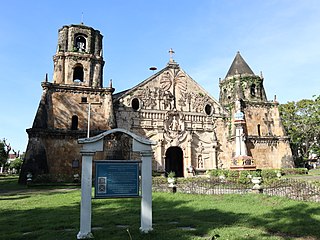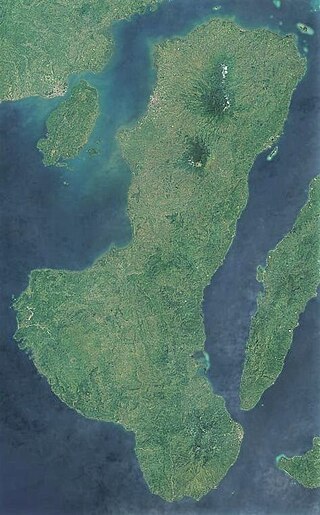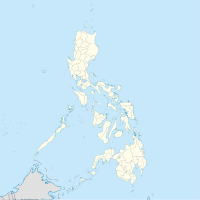
Bacolod, officially the City of Bacolod, is a 1st class highly urbanized city in the region of Western Visayas, Philippines. It is the capital of the province of Negros Occidental, where it is geographically situated but governed administratively independent.

Iligan, officially the City of Iligan, is a 1st class highly urbanized city in the region of Northern Mindanao, Philippines. According to the 2020 census, it has a population of 363,115 people.

San Pedro, officially the City of San Pedro, is a 3rd class component city in the province of Laguna, Philippines. According to the 2020 census, it has a population of 326,001 people.

Miagao, officially the Municipality of Miagao, is a 1st class municipality in the province of Iloilo, Philippines. According to the 2020 census, it has a population of 68,115 people.

Jordan, officially the Municipality of Jordan, is a 3rd class municipality and capital of the province of Guimaras, Philippines. The name itself should not to be confused with the country of Jordan, which had its capital at Amman. According to the 2020 census, it has a population of 39,566 people, making it the third largest settlement in the province.

Bago, officially the City of Bago, is a 2nd class component city in the province of Negros Occidental, Philippines. According to the 2020 census, it has a population of 191,210 people.

Himamaylan, officially the City of Himamaylan, is a 3rd class component city in the province of Negros Occidental, Philippines. According to the 2020 census, it has a population of 116,240 people.

Silay, officially the City of Silay, is a 3rd class component city in the province of Negros Occidental, Philippines. According to the 2020 census, it has a population of 130,478 people.

Talisay, officially the City of Talisay, is a 4th class component city in the province of Negros Occidental, Philippines. According to the 2020 census, it has a population of 108,909 people.

Cauayan, officially the City of Cauayan, is a 3rd class component city in the province of Isabela, Philippines. According to the 2020 census, it has a population of 143,403 people.

San Agustín, officially the Municipality of San Agustín,, is a 4th class municipality in the province of Romblon, Philippines. According to the 2020 census, it has a population of 24,115 people.

Pamplona, officially the Municipality of Pamplona, is a 3rd class municipality in the province of Camarines Sur, Philippines. According to the 2020 census, it has a population of 39,333 people.

Pili, officially the Municipality of Pili is a 1st class municipality and capital of the province of Camarines Sur, Philippines. According to the 2020 census, it has a population of 99,196 people.

Lopez, officially the Municipality of Lopez, is a 1st class municipality in the province of Quezon, Philippines. According to the 2020 census, it has a population of 94,657 people.

Pitogo, officially the Municipality of Pitogo, is a 4th class municipality in the province of Quezon, Philippines. According to the 2020 census, it has a population of 22,798 people.

The Bacolod Metropolitan Area, simply known as Metro Bacolod, is the 8th-most populous and the 6th-most densely populated metropolitan area out of the 12 metropolitan areas in the Philippines. This metropolitan area as defined by the National Economic and Development Authority (NEDA) has an estimated population of 1,435,593 inhabitants as of the 2020 official census by the Philippine Statistics Authority.

Negros is the fourth largest and third most populous island in the Philippines, with a total land area of 13,309 km2 (5,139 sq mi). Negros is one of the many islands of the Visayas, in the central part of the country. The predominant inhabitants of the island region are mainly called Negrenses. As of 2020 census, the total population of Negros is 4,656,945 people.

Socorro is a barangay located in Quezon City, Philippines, within the commercial district of Cubao. As of the 2019 census, the barangay has a population of 25,073 people. The barangay is home to Araneta City and Smart Araneta Coliseum, one of the largest indoor arenas in the world.

Sum-ag is a former town and constituent barangay of Bacolod. Located on the southernmost section of the city, it is considered the southern gateway of Bacolod, coming from different cities and towns of the south and the port of Pulupandan.

Granada is a former town and constituent barangay of Bacolod. Located on the easternmost portion of the city, it borders Northern Negros Natural Park.



















